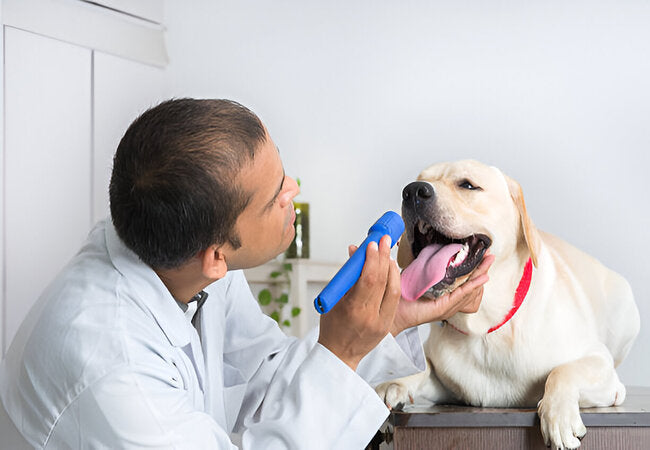Vet Guide 2025: Diagnosing & Treating Oral Cysts in Dogs 🐶🦷

In this article
Vet Guide 2025: Diagnosing & Treating Oral Cysts in Dogs 🐶🦷
By Dr. Duncan Houston BVSc
Hi, I’m Dr Duncan Houston BVSc, here to guide you through oral cysts in dogs—what they are, why they matter, and how we treat them effectively in 2025. My goal? Clear, caring advice that empowers every dog owner. 😊
1. What Are Oral Cysts? 🧬
Oral cysts—most commonly dentigerous cysts—are fluid-filled sacs that form around unerupted or impacted teeth. They’re benign, but left untreated, these cysts can press on teeth and jawbone, causing damage, pain, or even fractures.
Common Types:
- Dentigerous cysts: Around unerupted premolars, especially in small or brachycephalic breeds.
- Radicular/root cysts: Associated with chronically damaged teeth.
- Mucocele/sialocele: Accumulation of saliva from damaged ducts—not true cysts but similar—treated surgically.
- Gingival cysts: Rare adult soft-tissue cysts on the gums—usually harmless but removed if large.
2. Who's at Risk & Why?
Any dog can develop oral cysts—but the risk is higher in:
- Brachycephalic breeds (e.g., Pugs, Bulldogs): due to crowding and unerupted teeth.
- Toy breeds (e.g., Chihuahuas, Yorkies), and small breeds: same reasons.
- Mature dogs: Most dentigerous cysts are identified between ages 2–3, though they can appear from 6 months to 10 years.
3. Recognizing the Signs 🧐
Early stages often show no outward signs, but as cysts expand, typical signs include:
- Unexplained swelling or a blueish lump on the gums.
- Bad breath, drooling, reluctance to eat.
- Displaced, loose, or missing teeth.
- Pain or pawing at the mouth.
- In severe cases, jaw weakness or pathologic fractures.
4. Diagnosing Oral Cysts 🩺
Accurate diagnosis involves:
4.1 Physical Exam
Vet inspects mouth for swelling, discoloration, asymmetry, or missing teeth. Pawing, drooling, and appetite changes may also offer clues.
4.2 Dental Imaging
X‑rays are essential; advanced practices use cone‑beam CT for 3D detail. Radiographs show a radiolucent halo around tooth crowns, usually pathognomonic for dentigerous cysts.
4.3 Biopsy/Histopathology
After removal, the cyst lining is sent for biopsy to confirm the type and rule out rare malignant transformations (e.g. ameloblastoma).
5. Treatment Options 🛠️
The most definitive management is surgical. Here's the full protocol:
5.1 Cyst Enucleation & Tooth Extraction
- Remove the impacted tooth and fully enucleate (excise) the cyst lining—ideally en bloc (all in one piece).
- Curettage of the surrounding bone to reduce recurrence.
- If bone loss is significant, bone grafting may be used—or rely on natural clotting if still healthy.
- Follow‑up x‑rays for up to 2 years ensure successful healing.
5.2 Marsupialization (Staged Approach)
For large cysts near vital structures, we may first marsupialize—creating a drain to decrease size—followed by delayed full removal.
5.3 Drainage of Mucocele / Sialocele
Oral mucoceles or salivary sialoceles are treated with gland or duct removal, drains, or marsupialization; most dogs recover fully.
5.4 Medications & Post‑Op Care
- Pain relief: NSAIDs, opioids, or local blocks as needed.
- Antibiotics: Not routine, only if infection is present.
- Diet: Soft food for 10–14 days; no chew toys.
- Oral hygiene: Gentle cleaning to prevent plaque buildup—recommend Ask A Vet-approved dental chews from Woopf or Purrz.
6. Recovery & Aftercare 🏠
- Restrict activity: Soft food, no chew toys, leash walks only.
- Monitor incision: Watch for swelling, bleeding, and discharge.
- Checkups: Re-exam and x-ray at 6 and 12 months; then annually.
- Home dental care: Recommend professionally VOHC‑approved dental diets, daily brushing, and dental tools via the Ask A Vet app.
7. Prevention & Screening Tips ✅
- Puppy exams: Count premolars and assess eruption.
- Spay/neuter screenings: Many clinics check for unerupted teeth then.
- Regular dental visits: Annual exams with imaging, especially for at-risk breeds.
- Home dental care: Daily brushing, dental chews, clean water, and a healthy diet reduce secondary problems.
8. Breed-Specific Risks 🐾
Here's how certain breeds tend to be affected:
| Breed | Risk & Peculiarities |
|---|---|
| Pugs, Bulldogs, Shih Tzus | High crowding; likely unerupted premolars → early cysts. |
| Boxers | May have supernumerary teeth; often cysts are found during neuter checks. |
| Toy breeds | Small jaws, dental crowding → risk like brachycephalics. |
9. When to Consult a Specialist
If:
- Cysts are large or near nerves/jaw margins.
- X-ray shows bone destruction.
- The dog is high-risk for anesthesia or has concurrent disease.
In these cases, referral to a board‑certified veterinary dental specialist or surgeon is recommended.
10. Frequently Asked Questions (FAQs) ❓
- Will cysts come back?
- Rare if fully removed; incomplete excision increases recurrence.
- Can a cyst turn cancerous?
- Extremely rare, but biopsy confirms; malignant transformation documented in a few veterinary/human cases.
- How long is the recovery?
- Soft diet and care for 2 weeks; full bone healing may take 6–12 months.
- What if I can’t afford imaging?
- Ask your vet about payment plans or financing via Ask A Vet; early detection saves cost in the long run.
11. Final Takeaway from Dr Houston 🏁
Oral cysts are manageable—and often preventable—with proactive vet care, early detection, and proper surgical intervention. If you’re caring for a brachycephalic or toy breed, stay extra vigilant. When in doubt, schedule that check-up—early vets save smiles and jaws! 😄
For personalized dental tips, recovery support, and product recommendations (like dental tools from Woopf or soft‑food recipes via Purrz), download the Ask A Vet app today. 🐾📱 Expert 24/7 advice is just a tap away!






